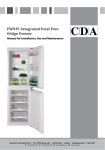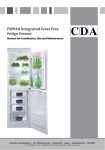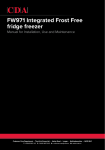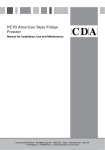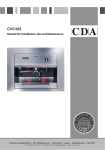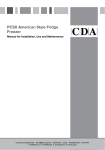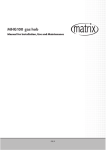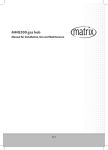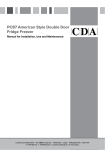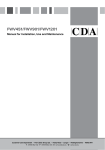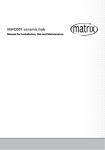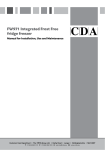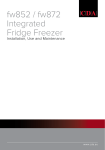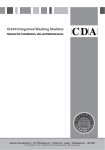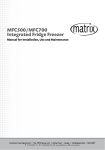Download CDA FW951 fridge-freezer
Transcript
fw951 Integrated Frost Free Fridge Freezer Manual for Installation, Use and Maintenance Customer Care Department • The Group Ltd. • Harby Road • Langar • Nottinghamshire • NG13 9HY T : 01949 862 012 F : 01949 862 003 E : [email protected] W : www.cda.eu Important The CDA Group Ltd cannot be held responsible for injuries or losses caused by incorrect use or installation of this product. Please note that CDA reserve the right to invalidate the guarantee supplied with this product following incorrect installation or misuse of the appliance. This appliance is not designed to be used by people (including children) with reduced physical, sensorial or mental capacity, or who lack experience or knowledge about it, unless they have had supervision or instructions on how to use the appliance by someone who is responsible for their safety. Under no circumstances should any external covers be removed for servicing or maintenance except by suitably qualified personnel. Appliance information: Please enter the details on the appliance rating plate below for reference, to assist CDA Customer Care in the event of a fault with your appliance and to register your appliance for guarantee purposes. Appliance Model Serial Number CE Declarations of Conformity: This appliance has been designed, constructed and marketed in 2 compliance with safety requirements of EEC Directive 2006/95/EEC (Low voltage) and requirements of EMC Directive 2004/108/EEC. This appliance has been manufactured to the strictest standards and complies with all applicable legislation, including Electrical safety (LVD) and Electromagnetic interference compatibility (EMC). Parts intended to come into contact with food conform to EEC/89/109.4 IMPORTANT INFORMATION FOR CORRECT DISPOSAL OF THE PRODUCT IN ACCORDANCE WITH EC DIRECTIVE 2002/96/EC. At the end of its working life, the product must not be disposed of as urban waste. The refrigeration system contains insulating gases and refrigerants, which require specialised waste disposal. The valuable materials contained in this appliance can be recycle. It must be taken to a special local authority differentiated waste collection centre or to a dealer providing this service. Before disposing of an old appliance, remove the door seals, latch or bolt lock to avoid the risk of child entrapment. Disposing of a household appliance separately avoids possible negative consequences for the environment and health deriving from inappropriate disposal and enables the constituent materials to be recovered to obtain significant savings in energy and resources. As a reminder of the need to dispose of household appliances separately, the product is marked with a crossed-out wheeled dustbin. 3 Important Never store inflammable or explosive items and strong corrosive acids or alkalis in the appliance. This is a household appliance, which is produced in accordance with the national standard. It is intended for food storage only, not for storage of blood, medicine and biological products. To prevent risk of fire, keep the appliance away from petrol or any other inflammables. To prevent risk of electromagnetic interference or other accidents, do not place a microwave oven on top of the refrigerator or use any electric appliance inside the refrigerator. Do not allow children to play with or near the appliance. The internal surface of freezer compartment is very cold when the appliance is running. Do not touch the surface especially when hands are wet. Do not splash water onto the appliance. Keep it away from places of high humidity that may have adverse effect on the electric insulation performance. This appliance is designed to be used in ambient temperatures between 16 and 43˚C. Use outside of this range may cause the appliance to fail. 4 Before First Use You must allow the fridge to settle for at least twenty four hours prior to switching the power on. It is recommended that you clean the interior of the appliance prior to first use, using a solution of bicarbonate of soda and warm water and then thoroughly drying the interior. The fridge may have an odour to it at first use. This will disappear as the appliance cools. Please note: The appliance will work continuously until it comes down to the correct temperature. The temperatures are preset at the factory to 5 for the fridge and -18 for the freezer. It takes two to three hours for the fridge and freezer to reach temperatures appropriate to store food. If the appliance is switched off, you should allow five minutes before switching it on again to prevent unnecessary damage to the compressor. 5 Use Fridge • Never put liquids in the refrigerator uncovered. • Never put hot foods in the refrigerator. Warm food should be allowed to cool to room temperature before being put into the refrigerator. • Nothing should rest against the rear wall of the refrigerator, as this will cause frost and possible condensation problems which will be difficult to remove. • Make sure food is clean and any extra water is wiped away before putting into the fridge. • Wrap or cover food before putting into the fridge. This will help prevent the loss of moisture, keep food fresh and avoid unpleasant odours. • Sort foods prior to storing. Any foods to be used soon should be stored at the front of the shelf to prevent deterioration caused by the door being open for prolonged periods. • Do not overfill the fridge. There should be sufficient space between the foods to allow the cool air to circulate. • Thawing frozen foods in the fridge compartment will help to keep the temperature low and save energy. Freezer • The freezer compartments are designed to store only frozen food. • Never put hot or warm foods in the freezer, allow them to cool fully before putting them into the freezer. 6 • Follow the instructions on the food packaging for storage of frozen food. If no information is provided, foods should not be stored for more than three months after the purchase date. • Store food in small packages (ideally less than 2.5kg). This reduces the freezing time and improves the quality of the food after thawing. • Wrap food before putting into the freezer. To stop the wrapping sticking together, ensure it is dry. • Label the food before freezing with information including type of food and dates of storage and expiry. • Once food is thawed, it must not be refrozen unless it has been completely cooked. Only defrost as much food as is required to prevent wastage. • Bottled or canned drinks should not be stored in the freezer compartment as they could explode. • Check the rating plate to confirm the maximum amount of fresh food that can be frozen within a 24 hour period. Do not attempt to freeze more than the maximum amount. 7 Storage The fridge section is for short term food storage. Although the temperature can be maintained between 0-10˚C, extended periods of food storage is not recommended. 1 As the cold air circulates within the fridge, the temperature can vary between the different sections. As such, foods should be stored in different sections according to type. Section 6 is the coldest part of the fridge. 4 5 2 6 3 7 fig. 1 1.Butter 2.Food in jars and bottles 3.Drinks , e.g. milk 4.Cooked food 5.Yogurts and cheese 6.Fresh meat and fish 7.Fruit and vegetables The fridge shelves can be moved according to the storage requirements within the fridge section. 8 fig. 2 To move the shelf, lift up the front section and then pull it outwards. To replace, slide the shelf back into the slot, and the lower the front section. The salad crisper is designed with a humidity control to ensure fruit and vegetables last longer. This can be adjusted by the slider at the front right of the salad crisper. Fully opening the slider control to high humidity restricts the amount of dry air entering the crisper from the fridge compartment, extending the life of items such as lettuce and cucumber. Open (fully left) = Low. Closed (fully right) = High. 9 Control Panel C A Mid REF . High FRZ. Low S.Cool fig. 3 Mid High Low S.Cool B A. Power button To put the fridge freezer on standby press and hold the power button for approximately three seconds. The power light will flash. To start the compressor working again, press and hold the standby button for approximately three seconds until the power light stays lit. B. Fridge thermostat dial The fridge temperature is regulated by this dial. The thermostat can be set between fully anticlockwise (super cool function) and fully clockwise (high - warmest setting). The super cool function can be used when introducing large quantities of fresh food to maintain an optimal temperature in the fridge section. To switch on the super cool function, turn the fridge thermostat dial to super cool. Once the food is sufficiently chilled, turn the thermostat dial back to the previous setting. IMPORTANT Do not use the super cool function for more than 24 hours. 10 C. Freezer thermostat dial The freezer temperature is regulated by this dial. The thermostat can be set between fully anticlockwise (super freeze function) and fully clockwise (high - warmest setting). The super freeze function can be used to freeze large quantities of fresh food as quickly as possible. To switch on the super freeze function, turn the freezer thermostat dial to super freeze. Once the food is frozen, turn the thermostat dial back to the previous setting. IMPORTANT Do not use the super freeze function for more than 24 hours. Door open alarm This appliance is equipped with an alarm that will activate when the fridge or freezer doors are left open for more than sixty seconds. If the fridge door is not closed, the alarm will sound three times every thirty seconds. 11 Care and Cleaning Always disconnect the appliance from the power supply before any cleaning or maintenance. Both fridge and freezer are frost free and as such this appliance is designed not to require defrosting. The fridge and freezer sections should be cleaned using a solution of bicarbonate of soda and lukewarm water. Do not use abrasive products or detergents. After washing, rinse and dry thoroughly. Clean the shelves and balconies separately by hand with soap and water. Do not put them in the dishwasher. Once cleaning is complete, then reconnect the power. If the appliance is not to used for prolonged periods of time, unplug and clean the appliance. The doors should be left slightly open to prevent the formation of mildew and smell. 12 Defrosting the Fridge The fridge is cooled by convection using cold air forced through channels at the rear of the fridge. No defrosting is required. Defrosting the Freezer The freezer is frost free and as such is designed not to require defrosting. To switch off the compressor for a short period of time and so to force a defrost cycle, push and hold the Audio Alert Release / Force Defrost button for approximately five seconds. After 20 seconds, the defrosting process will begin. 13 Troubleshooting If you have any problems with your appliance, you should check the troubleshooting prior to calling CDA Customer Care to prevent unnecessary service calls and potential cost. If the appliance is not working • Check there is power to the appliance. • The power button on the control panel is switched on. • The house fuses are intact and the fuse in the plug has not blown. • The thermostat is not set to off. • The plug socket is functioning fine. To check this, plug another electrical appliance in to see if the socket is faulty. The appliance is working, but not very well • The appliance is not overloaded. • The thermostat is set to an appropriate temperature. • The doors are closing properly. • The cooling system at the rear of the appliance is clean and free of dust, and not touching the rear wall. • There is enough ventilation at the side and rear walls. The appliance is noisy • The appliance is level and stable. • The side and rear walls are clear, and there is nothing resting on the appliance. 14 • The cooling gas in the refrigerator will make a slight bubbling noise, even when the compressor is not running. Please note: The LED lighting cannot be replaced without a service call. If the light fails, contact CDA Customer Care. 560-570 Installation This appliance must never be installed close to heat sources, e.g. heating elements, cookers or in damp places. 540 50 17761782 808 67 808 • The cooling system at the rear of the appliance must not touch the rear wall. • The appliance must be installed with adequate ventilation. Ensure that there is clearance above the appliance to allow air to escape and that there is space between the rear of the appliance and the wall. 200cm² 550 min 1773 min. 30 40 555 200cm² = airflow fig. 4 The diagram shows the ventilation requirements for your appliance. Failure to provide adequate ventilation can lead to increased running costs and premature failure and may invalidate the warranty provided with the appliance. 15 Ventilation The main consideration when installing any refrigeration unit into a fitted kitchen is ventilation. The heat removed from the cooling compartment needs to be dissipated into the atmosphere. Incorrect ventilation can lead to premature compressor failure, excessive power consumption and total system failure. For products intended to be installed into a tall housing unit, the following requirements need to be met: - The top of the cabinet needs to be vented into the room An air intake should be provided somewhere in the cabinet run to allow free air in. In this example, a plinth vent is shown underneath the refrigerator . Recommended size of vent opening: 500 x 35mm Refrigerator outline If the furniture does not allow free air into the room then a plinth vent, or other means of ventilation needs to be provided to ensure a natural flow of air A thin section of the plinth can be removed to allow air into the unit (recommended 600mm x 10mm) Min 30mm 300 300 fig. 5 16 plan view of cut out and ventilation gaps There should be space at the rear of the cabinet to allow cool air to be drawn over the condenser. Recommended: 500 x 35mm A hole should be cut in the supporting shelf, as shown below Important Please follow the instructions to install this unit. The open channel at the rear is clearly shown. For the correct operation of the appliance it is important that the top of the housing unit is not blocked off. A channel depth of 40-50mm is normal with most units. A hole is shown in the base shelf of the unit; this allows air to be drawn over the compressor & heat exchange. Some installers fit a decorative plinth vent. In most cases this is not required, but is a welcome aesthetic addition. As a rule, the more air can get in, the better and more efficient the operation of the product. 17 Fitting the Product Into the Cabinet 1. R emove the gasket protection pieces: The gasket protectors prevent excessive seal compression during transport and are required during the installation process. Remove the gasket protector from each door (fig 6) and proceed with the installation. Cover caps are provided to fill the hole; take care when inserting these. 2. Fitting the top fixing brackets: Secure the two top fixing brackets to the top of the product using two screws for each bracket, as shown in (fig 7) (a). fig. 6 B A fig. 7 Width spacer (One to be fitted top each hinge when 15mm cabinets are used) Door protection piece being used as a guide. 3. Fitting the front shelf trim: fig. 8 Note: The front shelf trim is mounted for transit inside the fridge at the back left. This must be removed from the transit location before the fridge is switched on. The front shelf trim fits to the top of the unit by hooking into slots on the 18 Guide piece simply slotted in to the fixing bracket fig. 9 top edge of the product (fig.7) (b). The trim piece should be fitted loosely at this stage to allow access to the top fixing brackets. 4. Fitting the magnetic seal strips: Two magnetic seals are supplied to fill the gap between the cabinet and the edge of the products. These simply fit against the left and right edges. To make it easier, it is useful to apply a little sticky tape to the top and bottom of each strip to prevent curling. Note that the seal may need to be cut to length. 5. Sit the appliance in the housing: L ift the appliance onto the supporting shelf (Ensure ventilation requirements have been met) and push the unit into until it is standing proud by between 50 and 75mm (Not important as long as the machine is stable). We recommend that you seek the help of another individual when handling this product. 6. Fitting the width spacers: For cabinets with 15mm thickness sides a small spacer is required to be fit. The spacer is shown in the next image. This ensures perfect alignment when installed. There are four spacers, two for the top hinges and two for the bottom hinges; these simply push into position on each hinge. 7. Fit the top hinge alignment guides (i.e. Gasket protection pieces): The gasket protection pieces double up as guides to ensure that the product is at the required depth in the cabinet when installed. Fit one to the top hinge and one to the bottom hinge, as shown in figure 9. 19 8. Fitting the bottom cabinet fixing bracket: A sliding bracket is provided to secure the non-hinge side of the product to the cabinet. This is fitted to the bottom of the product using two machine screws, as shown below. A guide piece is also provided to ensure the unit is aligned when installed. Fit the bracket and guide, as shown but do not tighten the securing screws to allow the bracket to slide left and right. Guide piece simply slotted in to the fixing bracket fig. 10 fig. 11 The fixing holes 9. P ositioning the product in the housing: A t this stage the product can be pushed into the housing unit, ensuring that the two guide pieces are fitted in the hinges and the guide is fitted to the lower fixing bracket. When the guides are flush against the front face of the cabinet sides the product is at the correct depth in the unit. Pull towards the fridge to break off the guide Decorative bracket trim fitted in place fig. 12 fig. 13 Slide the top cover into place so that it is flush against the top shelf Mid Mid High REF . Low S.Cool High FRZ. Low S.Frz fig. 14 20 At this stage ensure that the product is centrally aligned within the housing and then remove the guide pieces from the hinges. 10. Securing the product to the housing: Secure the product to the housing at the hinge side by using two screws in each hinge. The fixing holes in each hinge as shown in figure 10. 11. Securing the bottom fixing bracket: ith the lower guide piece in place slide the lower bracket against W the housing unit and tighten the two screws to lock the bracket in position (use a good quality screwdriver of the correct size for this). When done, secure the bracket to the cabinet side wall with a single screw, then snap off the guide piece and fit the bracket cover trim. 12. S ecuring the product to the top shelf: Finally, secure the product to the top support shelf using the fixing brackets fitted in step 2. When done, push the front shelf trim into position to cover the fixing brackets and any gaps. 21 Fitting the Cabinet Fascia Doors First, fit the upper fascia by following the steps below. After fitting the upper fascia in the correct position, use the lower edge of the upper fascia as a guide for positioning the lower fascia (A distance between the two fascias when installed is normally between 2 and 4mm) and fit the lower fascia. 1.With the door open and using the fitting guides, position the door in the required position with respect to the cabinet (figure 14). 2.Without moving the fitting guides, remove the upper fixing plate on the door by removing the fixing plate securing nuts (figure 15). 3.Place the fascia door upside down on a protective cloth or similar and position the fixing plate centrally in its required position, using the guides to help you (figure 16) and secure the plate in position using wood screws 22 Upper fixing plate (Dismantling) Refrigerator door Upper fixing plate fig. 15 Center line Cupboard door Fitting guide Refrigerator door fig. 16 Height adjustment screw Fascia fixing bracket fig. 17 fig. 18 of appropriate length. Please take care to ensure the screws selected will not punch through the fascia door. Under end face of fascia 4.Remove the fitting guides. 5.Attach the fascia door assembly to the refrigerator (onto the height adjustment screws) and loosely fit the securing nuts. At this stage the final vertical and horizontal position of the fascia assembly may need adjustment (figure 17). Fitting guides fig. 19 6.Check and align the position of the fascia door, as shown in the next section. When done, secure the fascia in position using the lower fascia fixing brackets and supplied screws (figure 18). 23 Adjusting the Position of the Fascia Doors The position of the fascia doors can be made in all 3 axes by following the guide shown below (figure 20). If the range of adjustment detailed below is not enough then the refrigerator is not located correctly in the cabinet and/ or the upper fascia fixing plates are incorrectly positioned. Horizontal Adjustment (Y): 1.Loosen the upper fixing plate nuts (B). 2.Slide the plate left or right as required; this gives approximately 5mm of adjustment. 3.Tighten the fixing nuts to lock the fascia in position. Vertical Adjustment (X): To adjust the vertical position of the door, use a 5mm spanner and turn the height adjustment screw as required. 24 fig. 20 Depth adjustment Cupboard door fig. 22 Depth Adjustment (Z): Ensure that the vertical and horizontal positions are correct before adjusting the depth. 1.Loosen the depth adjustment screw (C). 2.Move the fascia in or out, as required; this gives an adjustment of approximately 3mm. the lower fascia brackets are slotted to allow alignment of the fascia at the bottom. This is shown in figure 22. 25 Fitting the Trims and Cover Pieces 1. Open the door and lift out the decorative covers (marked ‘a’) in figure 20 fig. 23 2.Remove the position guides (d), turn them round so that the lip at the top faces outwards and insert them into the slots shown in the image (e); these will be used to line up the fascia panels before securing them in position. 3.Line up the fascia panel against the housing unit to determine where they need to be when installed and position the guides to the top of the fascia panel. Once this has been performed do not move the position guides. Cupboard door Refrigerator door Cabinet door fig. 24 fig. 25 fig. 26 4.Remove the mounting bracket (c) after removing the fixing nuts (b) and lay the mounting brackets with the guides in position over the underside of the fascia panel, as shown in figure 26 fig. 27 400. Secure the mounting bracket to the fascia panel using the provided wood screws, ensuring that the screws will not penetrate through the fascia where there are any rebates, etc. and then remove the guides. Any small errors, as in the image above, can be adjusted for after the fascia has been mounted. 5.Hang the fascia panel on the support pins and check that the fascia is positioned correctly. Adjustments can be made in all directions at this stage using the adjustment points shown in figure 26. Loosening this screw allows the fascia panel to be moved closer to or further away from the door. The left right and vertical position can be set using this screw. Insert a screwdriver in the slot at the top and move up (anti-clockwise) or down (Clockwise). Simply slide the bracket left or right to fine tune the horizontal position of the fascia. 6.To fit the lower fascia support brackets , secure each of them to the underside of the door with a single screw. At this stage do not fully tighten to allow adjustment to be made after the door is fixed in place. The fascia panel can then be secured to the bracket using two of the supplied wood screws. Finally, fully tighten the bracket mounting screw to fix the bracket at the required position and fit the cover trim pieces for the fascia mount brackets, as shown in figure 27. 27 Electrical Information Warning! This appliance must be earthed. Green and Yellow to Earth A 13 Amp Brown to Liv e B 13 Amp fuse Cord Clamp fig. 28 Blue to Neutra l The mains lead of this appliance has been fitted with a BS 1363A 13 amp fused plug. To change a fuse in this type of plug, follow the steps below: 1. Remove the fuse cover and fuse. 2. Fit replacement 13A fuse, ASTA approved to BS 1362 type, into the fuse cover. 3. Replace fuse cover. Important: Do not use the appliance without the fuse cover in position. How to connect an alternative plug If the fitted plug is not suitable for your socket outlet, then it should be cut off and disposed of safely to avoid possible shock hazard. A suitable alternative plug of at least 13 Amp rating to BS 1363 should be used. 28 As the colours of the wires in the mains lead of this appliance may not correspond with the coloured markings identifying the terminals in your plug, proceed as follows:• The wire which is coloured GREEN and YELLOW must be connected to the terminal which is marked with the letter (E) or by the Earth symbol or coloured GREEN and YELLOW. • The wire which is coloured BLUE must be connected to the terminal which is marked with the letter (N) or coloured BLACK. • The wire which is coloured BROWN must be connected to the terminal which is marked with the letter (L) or coloured RED. If in doubt regarding the electrical connection of this appliance, consult a qualified electrician. Do not shorten the supply cable, the appliance may require removing for servicing. N.B. Ensure that the plug socket is situated in an easily accessible place after installation. 29 30 31 Please contact our Customer Care Department for Service on the details below Customer Care Department • The Group Ltd. • Harby Road • Langar • Nottinghamshire • NG13 9HY T : 01949 862 012 F : 01949 862 003 E : [email protected] W : www.cda.eu
































